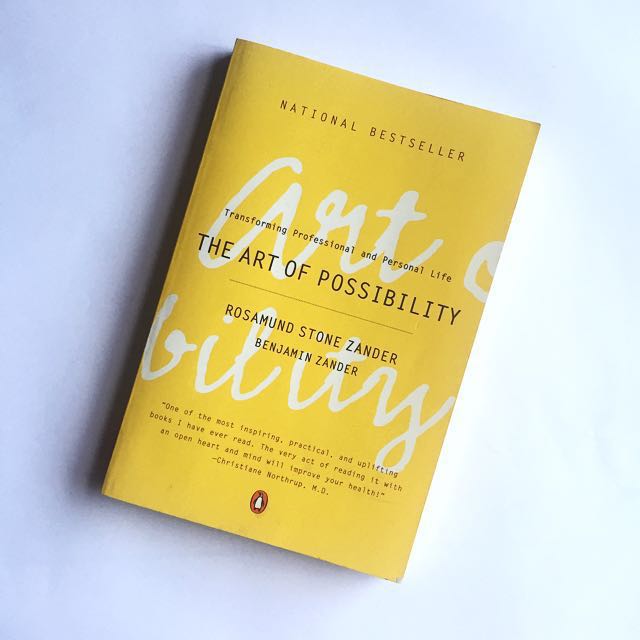My favorite way to ease into back-to-school is revisiting my favorite education books. After considering my feedback system, I realized that the first time I ever heard of going gradeless was when I read The Art of Possibility by Rosamund and Benjamin Zander.

Back in high school, my band director made band leadership students read the book in preparation for a leadership retreat. The entire book exudes passion and positivity - check out my favorite TED talk ever by Benjamin Zander for proof - but in particular, I re-read one chapter of the book called "Giving an A."
Grades were initially created out of necessity in the 1800s when the only other accepted way to rank students was social standing. The grade itself cannot describe the student’s work or understanding like meaningful feedback can. Even as teaching practices move forward, grades are still used primarily as a way to measure and compare people.
In the Zanders' point of view, "giving an A" means seeing the individual person and the dreams and promise within them. “When you give an A, you find yourself speaking to people not from a place of measuring how they stack up against your standards, but from a place of respect that gives them room to realize themselves” (p. 26).
Benjamin Zander means "giving an A" literally as well. In his music performance course, he noticed that students were too worried about how their performance would be measured to actually take creative risks. He decided to give all his students A’s to 1) help students embrace mistakes and 2) provide space for them to realize what’s possible.
Here's the assignment he required of students in his course:
When I give my students an A, and my students envision the best version of themselves, here’s the conversation that’s possible: How are you doing at realizing the person you want to be? How can you continue to grow in that direction? And, how can I better help you grow?

Back in high school, my band director made band leadership students read the book in preparation for a leadership retreat. The entire book exudes passion and positivity - check out my favorite TED talk ever by Benjamin Zander for proof - but in particular, I re-read one chapter of the book called "Giving an A."
Grades were initially created out of necessity in the 1800s when the only other accepted way to rank students was social standing. The grade itself cannot describe the student’s work or understanding like meaningful feedback can. Even as teaching practices move forward, grades are still used primarily as a way to measure and compare people.
In the Zanders' point of view, "giving an A" means seeing the individual person and the dreams and promise within them. “When you give an A, you find yourself speaking to people not from a place of measuring how they stack up against your standards, but from a place of respect that gives them room to realize themselves” (p. 26).
Benjamin Zander means "giving an A" literally as well. In his music performance course, he noticed that students were too worried about how their performance would be measured to actually take creative risks. He decided to give all his students A’s to 1) help students embrace mistakes and 2) provide space for them to realize what’s possible.
Here's the assignment he required of students in his course:
“Each student in this class will get an A for the course,” I announce. “However, there is one requirement that you must fulfill to earn this grade: Sometime during the next two weeks, you must write me a letter dated next May, which begins with the words, ‘Dear Mr. Zander, I got my A because…,’ and in this letter you are to tell, in as much detail as you can, the story of what will have happened to you by next May that is in line with this extraordinary grade.”Beautiful, right? I’m SO glad that I happened to read this chapter just in time for the school year. It’ll be my first official assignment in my entrepreneurship course. Then, this letter will be the benchmark for all future reflections and conferences with students, because what better way to write your goals than to describe your future self?
In writing their letters, I say to them, they are to place themselves in the future, looking back, and to report on all the insights they acquired and milestones they attained during the year as if those accomplishments were already in the past. Everything must be written in the past tense. Phrases such as “I hope,” “I intend,” or “I will” must not appear. The students may, if they wish, mention specific goals reached or competitions won. “But,” I tell them, “I am especially interested in the person you will have become by next May. I am interested in the attitude, feelings, and worldview of that person who will have done all she wished to do or become everything he wanted to be.” I tell them I want them to fall passionately in love with the person they are describing in their letter. (p. 27-28)
When I give my students an A, and my students envision the best version of themselves, here’s the conversation that’s possible: How are you doing at realizing the person you want to be? How can you continue to grow in that direction? And, how can I better help you grow?
[…] Benjamin and Rosamund Zander’s The Art of Possibility, in which they have a chapter called “Giving an A,” I decided to go gradeless and give each student an outright A for a few […]
ReplyDelete[…] my startups class, students write me a letter in which they visualize wild success for the year. As a teacher, I help them achieve this better […]
ReplyDelete